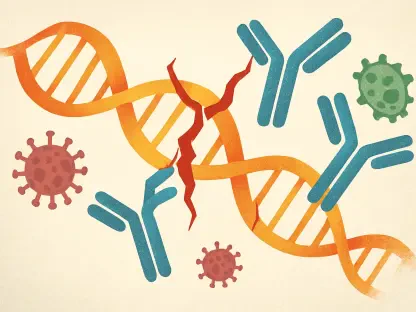Teeth play a crucial role in the human body, primarily in breaking down food. They are protected by enamel, which allows them to endure significant stress during chewing. Unlike other bodily materials, enamel lacks the ability to self-repair, making it susceptible to deterioration over time. As people age, enamel can weaken, heightening the risk of damage. Researchers at the University of Washington and the Pacific Northwest National Laboratory have conducted a study to understand how the atomic composition of tooth enamel changes with age. This study aims to provide insights that could lead to better methods for preserving dental health over time.
Investigating Enamel’s Atomic Composition
The Importance of Enamel
Enamel is the hardest substance in the human body, primarily composed of minerals arranged in structures that are ten thousand times smaller than a human hair’s width. It protects teeth from the wear and tear of daily activities such as chewing and grinding. However, enamel’s inability to self-repair makes it vulnerable to damage over time. Understanding how enamel changes with age is crucial for developing strategies to prolong the longevity and health of teeth.
This protective layer’s mineral content significantly influences its mechanical properties, affecting enamel’s hardness and brittleness. As people age, the enamel becomes more prone to wear and tear, increasing the risk of dental issues such as cracks and cavities. The researchers aimed to delve deep into the molecular structure of enamel to gain insights into the exact changes that occur as humans age. By doing so, they hoped to uncover potential interventions that could mitigate these age-related changes and improve dental health outcomes for older adults.
Research Methodology
The research team focused on analyzing the atomic composition of enamel in two human teeth samples—one from a 22-year-old and the other from a 56-year-old. They utilized a technique called “atom probe tomography,” which allows for the creation of a 3D atomic map of a sample. This method enabled the researchers to examine the detailed distribution of minerals and organic material within enamel at an atomic scale.
This advanced imaging technique offered a unique glimpse into the nanoscale changes in enamel, providing a more nuanced understanding of its structural integrity. By creating three samples from each of the two teeth studied, the team analyzed differences in element composition in three specific areas within the enamel structures: the core, the surrounding shell, and the space between the shells. This level of detail proved instrumental in identifying how various elements, including fluoride, are distributed throughout the enamel at different stages of life.
Key Findings on Fluoride Integration
Fluoride Levels in Aging Teeth
The team discovered that the older person’s tooth sample had higher levels of fluoride, an ion commonly found in drinking water and toothpaste. Fluoride is typically added to these sources to help protect enamel. The study indicates that fluoride is integrated into enamel as people age, particularly in the shell regions of the enamel structures. This finding highlights the importance of fluoride in maintaining dental health over time. Fluoride is known for its ability to enhance the enamel’s resistance to acid attacks, thereby preventing decay.
The incorporation of fluoride into the enamel matrix over time suggests that consistent exposure to this element, whether through drinking water or oral hygiene products, can fortify the enamel against degradation. Interestingly, the fluoride levels were notably higher in the outer regions of the enamel, where the material’s exposure to external sources would be most significant. This discovery aligns with existing dental recommendations advocating for the use of fluoride products as a preventive measure against cavities and enamel wear.
Implications for Dental Health
Understanding the variation in mineral content, which significantly influences enamel’s mechanical properties, is crucial. The increase in brittleness, particularly at the tooth’s outer surface where cracks usually begin, is a key factor in aging teeth. By tracing fluoride incorporation into actual teeth at a minute scale, researchers can better understand how to preserve enamel and prevent damage as people age. This detailed knowledge could lead to more tailored dental treatments and preventive strategies.
The study’s findings underscore the potential benefits of sustained fluoride exposure throughout a person’s lifetime. Dental professionals might leverage this information to emphasize the importance of incorporating fluoride into daily oral hygiene routines, especially for older adults. As research progresses, it could also lead to the development of new dental products and treatments designed to strengthen aging enamel, thereby reducing the prevalence of age-related dental issues.
Interdisciplinary Collaboration
Combining Expertise
The interdisciplinary nature of this work is a focal point of the study. Arun Devaraj, a materials scientist at PNNL, expressed how his collaboration with Dwayne Arola, which began in 2015, leveraged their combined expertise to understand biomaterial behavior better. Since Jack Grimm joined their team in 2019, he helped deepen the analysis. Interdisciplinary science fosters innovation and can address interesting questions regarding how teeth age.
This collaboration brought together experts in materials science, dentistry, and advanced imaging techniques, resulting in a more comprehensive understanding of enamel’s atomic composition. Such partnerships are vital in exploring complex biological questions, enabling researchers to draw on a diverse range of perspectives and methodologies. This holistic approach is essential for tackling multifaceted issues, such as the aging of dental tissues, which intersect multiple scientific disciplines.
Future Research Directions
Another research interest for the team is the change in protein composition within enamel over time. Their initial objective was to map the distribution of organic content within enamel and determine if the minimal protein present decreases with age. However, the pronounced distribution of fluoride around the crystalline structures became one of the study’s most notable findings. This discovery opens new avenues for future research on the effects of aging on tooth enamel.
The team is also keen to explore the role that other trace elements and organic molecules play in enamel’s durability and how these factors evolve with age. By building on their groundbreaking work, they aim to uncover additional insights that could inform new dental preservation techniques. Future studies might include larger sample sizes and more detailed records of fluoride exposure and dietary habits to refine their understanding of enamel’s aging process further.
Practical Applications and Public Guidance
Dental Recommendations
Reflecting upon these discoveries, there is no definitive public guidance yet on how aging impacts teeth beyond the general dental recommendation to use fluoride products to combat tooth decay. The study’s findings provide valuable insights that could inform future dental health preservation strategies. By understanding how fluoride integrates into enamel structures over time, dental professionals can develop better methods for maintaining oral health as we age.
The knowledge gained from this research could potentially lead to updated guidelines on fluoride usage and new preventive measures tailored to the needs of an aging population. Dental practitioners might also employ this information to advocate for more personalized dental care plans, emphasizing the long-term benefits of fluoride and other protective agents in maintaining enamel integrity.
Ongoing Discussions in Dental Science
Teeth are vital for the human body, mainly because they break down food, allowing for proper digestion. Enamel, the hard outer layer of teeth, shields them from the intense pressure and wear that occurs during chewing. However, enamel lacks the ability to regenerate, rendering it vulnerable to wear and tear over time. As people get older, their enamel often becomes weaker, increasing the likelihood of dental damage. To address this issue, researchers from the University of Washington and the Pacific Northwest National Laboratory carried out a study examining how the atomic structure of tooth enamel alters with age. Their research aims to offer insights that could lead to improved techniques for maintaining dental health throughout a person’s life. By understanding these changes on an atomic level, scientists hope to develop better preventive measures and treatments to protect tooth enamel from deterioration, ultimately promoting better oral health as people age.









